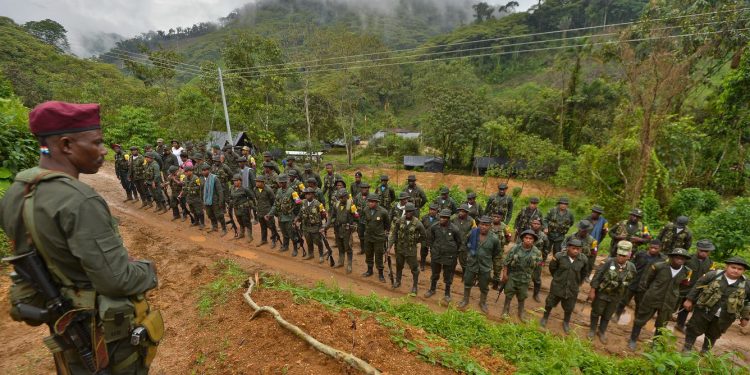The Biden administration has outlined how it will use its power to designate different groups as terrorists as part of its foreign policy efforts.
Secretary of State Antony Blinken took the Colombian rebel group the Revolutionary Armed Forces of Colombia, known as the FARC, from the US Foreign Terrorist Organizations list in late 2021.
I know the importance of this decision. because I worked on adding and removing groups and individuals on various lists including Foreign Terrorist Organizations.
What use are terrorist lists?
In 1997, the US government began labeling groups as foreign terrorist organizations to highlight the threat they pose. Shortly after the terrorist attacks of September 11, 2001, President George W. Bush signed Executive Order 13224 expanding the ability of the State and Treasury Departments to also sanction individuals who participated in terrorist activities.
The terrorist designation process is very complex and involves the State Department reviewing intelligence information and conducting an intensive legal review.
Groups and individuals are added to the Department of State’s Foreign Terrorist Organizations and Executive Order 13224 lists regularly, but decisions to remove groups from these lists are less common.
Simply put, most terrorist groups don’t want to lay down their weapons, which is the only way to get off US lists.
In late 2021, the State Department added two more Colombia-based splinter terrorist groups to the lists: the Revolutionary Armed Forces of the People’s Army of Colombia, known as FARC-EP, and Segunda Marquetalia .
The State Department also sanctioned six senior leaders of the FARC-EP and Segunda Marquetalia.
Why it makes sense to remove the FARC
The FARC were an enduring and central part of the Colombian conflict, which lasted more than 50 years. The FARC officially ended its reign over approximately 25% of Colombian territory in 2016 when it reached a peace agreement with the Colombian government.
The implementation of the peace agreement during the last five years has been difficult.
Thousands of FARC members were unwilling to embrace the peace deal and fought over territory and drug markets with rival groups.
Mass killings continued after the agreement. and close to 5 million people remain internally displaced as a result of the conflict.
Former FARC leaders, such as Iván Márquez, have announced that they will no longer follow the peace agreement.
The Colombian government continues to implement the peace agreement, which calls for more investment in rural communities—where the FARC once dominated—and in basic services for the population, such as drinking water.
However, the decision to remove the FARC from the State Department’s FTO list made sense to me and to me. other experts because the FARC has lived up to the key elements of the peace agreement. The FARC have turned in his arms and made a good faith effort to become part of the Colombian political system.
The political party of the FARC, communes has had “sad” electoral results in recent years, according to the think tank International Crisis Group.
Getting off the FTO list is complicated
Today, the FTO list has over 70 groups on it. Only 15 groups have been removed from the list since 1997, including the Khmer Rouge, the communist regime that ruled Cambodia in the 1970s .
Getting terrorist groups off these US government blacklists is difficult.
Governments of countries where terrorist groups historically operate are often reluctant to support a US decision to change the list, as this may distress civilians and government officials harmed by these groups.
It is also difficult because the named terrorist groups often have a very bloody history. That goes for the FARC, which may be responsible for more than 100,000 deaths.
There are a few ways to remove a group from the FTO list. In one scenario, a terrorist group has been defeated.
There is no doubt in my experience that factions in the Colombian government were upset by the US decision to remove the FARC from the FTO list.
One of the most important political maneuvers that can make such a political move less controversial is adding new groups and individuals from the same conflict to blacklists.
The inclusion of two new Colombian groups and six individuals on the terrorist lists showed Colombia that the United States remains concerned about the terrorist threat landscape there.
When Blinken removed the FARC from the FTO and Executive Order 13224 lists on November 30, 2021, he also added other Colombian-based groups and individuals to the terrorist lists.
Consequences of being named on the FTO list
In the US sanctions system, there are three key consequences if a group is listed as a terrorist organization.
First, identified terrorist groups are excluded from the US formal financial system, which means their bank accounts are frozen.
Second, anyone who tries to do business with these groups can end up behind bars for up to two decades.
Third, anyone who is linked to a listed terrorist group can never set foot in the US due to visa restrictions.
Blinken’s decision to remove the FARC from the FTO list, while adding other groups and individuals, may indicate that the Biden administration will use terrorist sanctions tools in complex ways.
Instead of simply adding groups or individuals to the lists, the Biden team may be more willing to remove groups that have ceased their violent activity in conflicts. By doing this, the Biden administration can enhance the credibility of the FTO list by making it more dynamic and open to conflicts and changing political climates. It would also demonstrate that there are benefits if listed terrorist groups and individuals participate in a political process.

